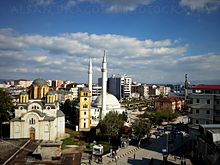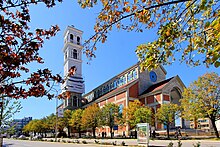Religion in Kosovo
The Catholic Albanian communities are mostly concentrated in Gjakova, Prizren, Klina and a few villages near Peja and Vitina (see Laramans).
[3]: 2 Protestant leaders and those without a religious affiliation state some members of their communities were classified incorrectly as Muslims by census takers.
[7]: 110 According to the 2012 European Social Survey, the population of Kosovo was about 88% Muslim, 5.8% Catholic, 2.9% Eastern Orthodox, 2.9% irreligious, 0.1% Protestant and 0.4% another religion.
[12] Christianity probably reached Kosovo in the 5th century as the Roman Empire gradually split into a Greek East and Latin West.
[13]: 60–61 During the High Middle Ages, as Byzantine rule in Kosovo gave way to the Serbian Empire in the early 13th century, there was an Orthodox Christian majority, but also a Catholic minority consisting of the Italo-Dalmatian merchant class from Ragusa, German immigrants from Hungary and Transylvania, and probably all of the native Albanian population.
Although the Ottomans did not force the Catholic and Eastern Orthodox Christian population to convert to Islam, there was strong social pressure (such as not having to pay the jizya) as well as political expediency to do so, which ethnic Albanians did in far greater numbers (including the entire nobility) than Serbs, Greeks and others in the region.
During the Concilium Albanicum, a meeting of Albanian bishops in 1703, a strict condemnation of conversion – especially for opportunistic reasons such as jizya evasion – was promulgated.
Whilst many of these converts stayed crypto-Catholics to a certain extent, often helped by pragmatic lower clerics – the higher Catholic clergy ordered them to be denied the sacraments for their heresy.
When the Laramans of Letnica asked the district governor and judge in Gjilan to recognise them as Catholics, they were refused however, and subsequently imprisoned, and then deported to Anatolia,[15]: 93 from where they returned in November 1848 following diplomatic intervention.
The pace of conversions to Islam only increased significantly in the second half of the sixteenth century, possibly because converts thus became exempt from the cizje, a tax levied only on non-Muslims.
[13]: 130 Besides the ethnic Albanians, and the ruling Turks who settled in Kosovo, the Roma and some part of the Slavic-speaking population (later called the Bosniaks or Gorani, to distinguish them from the Orthodox Serbs) also became Muslims, most of them, by far, Sunni; many of these belong to Sufi brotherhoods, although small a minority of Shia Muslims[dubious – discuss] formed in the countryside.
However, the Law on Freedom of Religion prevents some religious communities from registering as legal entities, a designation that would allow them to more easily buy and rent property, access burial sites, establish bank accounts, and carry out other administrative activities.
In January 2023, the government approved draft legislation amending the law on religious freedom, with the aim of deepening interreligious tolerance.




